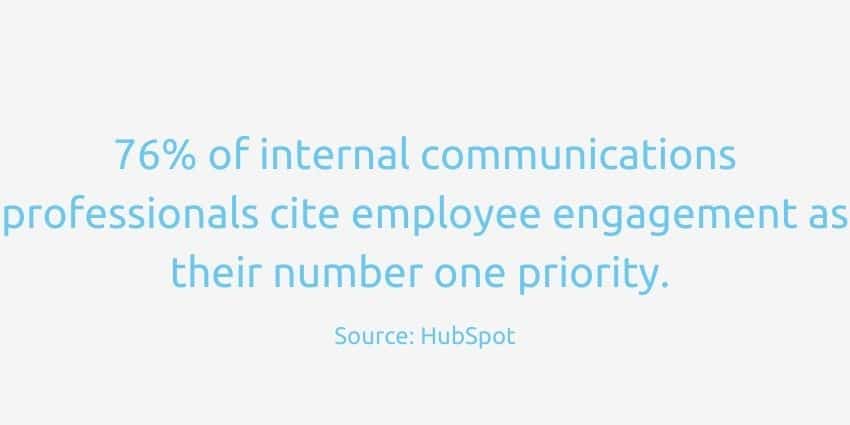First published on Journal du Net by Matthieu Silbermann, Chief Product Officer at Powell Software.
In terms of internal communication, small businesses (typically having 20 to 300 employees) have the same needs as larger companies while battling limited resources: often not having an internal communications department or IT team large enough to create dedicated digital solutions.
Therefore, internal communication often relies on tools such as email, Microsoft Teams or Slack.
In this article, we’ll see the limitations of such an approach and discover that there is a better internal communications solution for small organizations.
What are the challenges of internal communication in small businesses?
Communicating necessary information
Regardless of the size of an organization, sharing information is key to its success. The challenge is ensuring all employees have access to the information necessary for the proper execution of the company’s processes. They need to be able to find the latest news and official documents.
Helping employees work better, even remotely
This requirement has only increased since the pandemic, as remote work accelerates the need to streamline sharing of information and documents. The situation is expected to last with the implementation of hybrid working: some employees on-site, others remotely depending on the day of the week.
Small organizations need to help employees to work better on a daily basis by facilitating access to information. Yet above all, by setting up a structure that allows them to easily understand where this information is located, the reference documents, and the tools to use.
Engaging all employees in an inclusive corporate culture
With hybrid work, effective communication is not only about information strictly related to business; it is also a question of engaging all employees. They need to feel a sense of belonging to the company reflected in its culture and values. This does not only concern employees who have a PC and access to digital tools, but must also include field workers via their professional or personal smartphones.
Creating social connections between dispersed teams
With 2 or 3 days of remote work per week, the informal link of the coffee machine and lunch breaks are threatened. Sometimes going as far as creating a feeling of isolation among employees especially younger workers.
There are digital communication solutions to this: even remotely we can organize social moments around informal online meetings or by organizing virtual games between employees.
The success of companies now depends on their ability to implement a sustainable and balanced solution that meets these business and HR challenges.
How long are emails and shared directories enough?
Proliferation of e-mails
The most frequent objection to the implementation of a digital workspace in small companies is: “Today we send information by email or by Microsoft Teams and we store documents in SharePoint”. Yet when we question employees, we realize that emails have a limit: their proliferation. It’s hard to separate important information from unsolicited emails and find a mail that was sent several months ago.
As soon as an organization has more than 10 or 20 employees, it is necessary to move to a more structured and organized space, what we commonly call a corporate intranet or digital workplace.
Fighting Infobesity
Many employees are becoming tired from information overload, receiving too many emails or video calls and their digital well-being is suffering.
An internal communications tool, like the digital workplace, helps to fight against this feeling of digital fatigue of employees “infobesity” in two ways. It prevents information from being lost, or various versions of documents causing confusion. It also makes it possible to structure the collective intelligence of the company and contributes to the establishment of a more engaged culture around.
Beyond an internal communication tool, a space for collaboration
Improving internal communications relies on a solution that goes beyond just communication, to allow collaboration at all levels.
Promoting exchanges
Beyond top-down communication, employees want to be able to react and share news, developing a sense of belonging.
In addition, structuring exchanges with the establishment of a collaboration space promotes collective intelligence:
- Answering a question from a colleague to save time
- Share recent experiences to crystallize good practices
- Propose an idea and enrich it to many
Centralize digital solutions
The digitalization of companies quickly involves having a reference portal from which everyone can access different digital tools. This is one of the other challenges to address through a dedicated digital space:
- HR tools: book your office, take your leave, fill out your expense reports
- Office tools: online document search, corporate directory
- Tools to foster social connection: informal and light online coffee breaks
Some points to consider in choosing your internal comms solution
There are many intranet portals or digital workplace solutions on the market. To choose the right one, you’ll want the following:
- A space that combines both communication and collaboration on a daily basis
- Functional richness to meet the objectives of hybrid working
- Secure data and exchanges in world where cyber-attack risks are increasing
It is also necessary to check if it has been designed for large organizations that have IT teams or dedicated communication teams to set up and bring the portal to life.
Conversely, some out-of-the-box solutions have limited scalability: they don’t grow and adapt to the needs of companies.

Fortunately, there is now an internal communications solution to meet all these challenges that is:
- Easy to set up and go live even for non-experts
- Scalable to support the growth of small organizations
- Integrated with your Office 365 office automation solution and Microsoft Teams
Together is the small business communication and collaboration space in Microsoft Teams. Designed for SMEs, Together is the small business intranet you need to bring internal communications to life in your organization.







